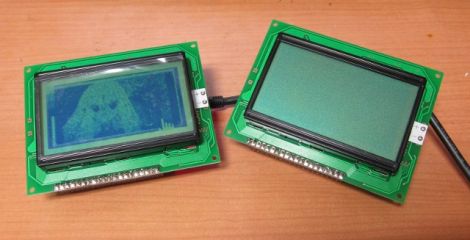
[Ko] wanted to add an extra monitor to his computer, but he wasn’t looking for something huge that would sit atop his desk – he desired something smaller, much smaller.
His ChibiMo mini USB monitor is a neat little creation that lets you extend or mirror your Windows desktop onto a tiny 128×64 pixel LCD panel. At first glance you might think that it is too small to be useful, but it is recognized in Windows in the same fashion as any standard monitor. This means that it would be quite easy to load system monitoring software solely on the LCD panel, keeping the clutter off of your main display.
The display is wired to an Arduino like any other standard shield, and is connected to his computer via a USB cable. Once the ChibiMo sketch is uploaded to the Arduino, the display driver needs to be loaded on the PC. This allows you to tweak the ChibiMo’s display settings in Windows’ display manager.
It’s a great concept, one we would love to see explored further. As of right now, the ChibiMo is only supported on x86 versions of Windows XP, and we weren’t able to find source links anywhere on his site. Perhaps there are some talented members of our community who would be interested in taking a whack at it…














thats great! but for the price he paid for the arduino and lcd plus the time he used in creating it, he could have bought a small 4inch usb lcd off ebay and saved himself the trouble. but i still love the hack. this would be way cooler if he used a VFD.
I didn’t know you could do pwm on an lcd display :P.
Kudos for the hack.
@sariel
4 inch usb lcd? for around $50? clearly my ebay skills fail. have any examples?
*Hint: Hit the Japanese link in the upper right corner, then scroll down a little for a video.
I need to make this, maybe port the code to one of the PICs I have lying around….
This is the same resolution that my TRS-80 model 1 had.
Anything that displays anime/manga pictures is the best ;p
Anyone care to have a look at the code please? I wanted to have it worked on a MEGA which is the only Arduino I have. Is it possible to adopt the code for MEGA? Thanks in advance.
Video site requires registration >.<
http://www.mediafire.com/?c889ac1p45lg842
Video made easy if anyone wants to watch it without the effort I had to go through ;p
If anyone is wondering, i think the first picture is from the anime ‘Katanagatari’ (http://brianosaure.com/wp-content/uploads/2011/01/Katanagatari3.jpg)
The second picture (on his website) is of Anzu from ‘Hanamaru Kindergarten’ http://www.japanator.com/elephant/ul/13142-620x-Hanamaru6.jpg
Pretty ingenious, very similar concept to sprite_tm’s digital picture frame hack.
Although the latter was never designed to act as a second display though.
Next step, phase sequential colour via RGB LED backlighting.
The panel ought to support writing at higher speed than designed, you will get some ghosting but this might not be a problem at ambient temperature.
One of the suggestions for making large area E-ink screens for outdoor advertising was to preheat the panel above 15 Celsius using a flat panel heater but only before changing the content so it could sit there for weeks if need be before being rewritten.
please, source the driver
@bothersaidpooh
Do you have any examples of someone making a colour screen out of a B/W LCD display?
Leaving another comment because I don’t know of an easier way to subscribe to comment notifications.
@Nardella
I saw a mod of a TI-83 that had a RGB backlight that had 8-color support on it. Looking on Google turned up no signs of that site (or pictures) anymore.
@Nardella
Yes, this technique was used on some early JVC camcorders because the technology of the time wasn’t up to making colour LCDs in viewfinder size.
Interestingly there was an article in Practical Wireless circa 1960 detailing a way to make a “pseudo-colour” CRT display using a B/W CRT with a switching filter of some kind.
Hey, I’m pretty interested in getting something like what sariel said. Anyone know where I could get one?